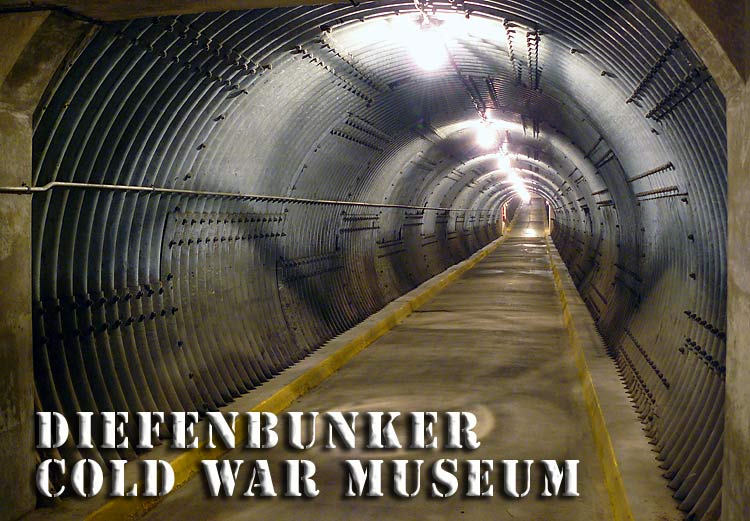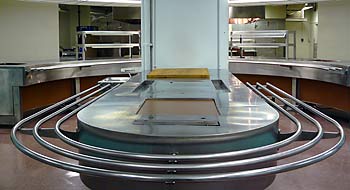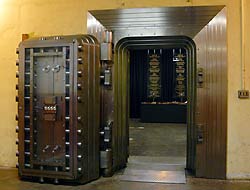Diefenbunker Museum
The Diefenbunker Cold War Museum is located in the township of Carp about 20 minutes west of Ottawa, Canada.
The Diefenbunker museum is completely different from any other museum I've covered in this military museum directory. The Diefenbunker Cold War Museum is a subterranean reinforced concrete labyrinth of bunkers designed to house the most critical members of the Canadian government in the event of a nuclear attack from the Soviet Union. While very comprehensive in facilities and space, there was no provision for the personnel to bring their wives or children with them to survive the aftermath of the expected nuclear holocaust. The bunker complex was built during the term of Prime Minister John Diefenbaker, and eventually was tagged with its current and very appropriate title. Our tour guide said that when Canadian Prime Minister Trudeau learned he could not bring his family with him in the event of a nuclear attack, he vowed never to set foot in the facility even if the worst were to happen.
Diefenbunker Fun Facts:
Blast Resistance: 5 megaton thermonuclear bomb blast at 1.1 miles from ground zero
Wall Thickness: 2.5 to 4 feet reinforced concrete
Surrounding Material: 5 feet of gravel to help with drainage
Support Columns: 4.5 ft diameter, 36 total on 22 ft centers
Amount of Concrete Used: 32,000 tons
Rebar Used: 5,000 tons, 2 inch in diameter
Interior Floor Space: 100,000 square feet
Number of Levels: 4
Facility total land area: 80 acres
Design Occupancy: 535 People for 30 days
Number of workers building the facility: 1,000
Construction Started: 1959
Time to Build: 2 years
Cost: $20,000,000
Most of the images here are kind of mundane, like the interior of an office building. But seen in the context of being in an underground concrete reinforced bunker, they do become a bit more interesting. Also the Diefenbunker staff and volunteers have done a good job in sourcing period desks, chairs, and other office equipment from the 50s which give the museum a time capsule feel.
My friend and host, Dixon Kenner of Ottawa added the following:
DK:
When it was decommissioned, what to do with the facility became a question. Numerous proposals were floated, from handing the facility intact to Heritage Canada (who would seal it up in situ, unchanged, for reopening in fifty years) to filling it full of water fro scuba divers. Given the lack of decision, National Defense emptied the bunker as scrap in preparation of its disposal given soil contamination etc. Historically speaking, this was unforgivable, but understandable given the bureaucratic mind set.
Our tour guide mentioned that when the project was cancelled after Prime Minister Trudeau vowed not to set foot in it, most of the interior contents were stripped and sold off.
DK: The facility was not decommissioned until the 1990's, after Trudeau had retired. It was offered up for possible savings as a result of the end of the Cold War. Its disposal has since be argued to have been a mistake given developments.
One exception is "The Lost Bedroom". This one bedroom for some reason was left untouched while all the others were stripped. It retains all the bunk beds, lockers, and shelves that all the Diefenbunker bedrooms were equipped with originally. It may have been oversight, but I'd like to think it was a conscious decision by some employee to save a piece of the original sleeping quarters for future generations to see.
Unlike other military museums in this directory, there are no weapons. Except, I suppose for the big honking Mk VI thermonuclear bomb casing on display outside the inner entrance (actually, it is a very well done reproduction). A smaller and apparently real B43 Thermonuclear bomb casing is just inside the entrance, as well as a practice free fall bomb. There were also some pistols in the weapons locker, all of which were plastic.
When you enter the Machine Room areas, look at the mounting bases of all the boilers, blowers, and other equipment. You will see all are mounted on heavy coil springs to reduce the shock transmitted to each by the seismic forces generated by a multi megaton nuclear blast. Oddly the generators themselves are not shock mounted.
The Canadian Broadcasting Corporation's broadcasting room has been refurnished with some of its original equipment and turntables. I'm not sure how they would have been able to broadcast had the large antenna mast on the surface had been vaporized by a Soviet nuclear bomb blast.
DK: There were underground transmission lines to an antenna farm near Almonte. The studio is essentially complete.
The Civil Situation Center has floor to ceiling white board tables listing simulated statuses on bomb impacts, casualties, and infrastructure in the aftermath of a nuclear first strike by the USSR.
The gold vault is, well, a big vault with a bank safe door to get in. What is different about this vault from your local S&L's vault is its size. It is very wide and very tall, tall enough to contain all of Canada's gold reserves. Another interesting feature is a secondary vault door that was necessary to install to allow pressure equalization between the chamber and the outside atmosphere. Apparently the main door is air tight enough that if there is much of a change of barometric pressure, the suction or pressure on the door is enough that it cannot be opened. So there is this smaller door with an air valve that can be opened to equalize the pressures and allow the main door to be opened. Another curiosity about the gold vault is the narrow corridor that surrounds all four walls floor to ceiling. There are mirrors at each corner and a guard can look and see anyone who is in the corridor at any point from any other point. It seems kind of silly, at the bottom of a reinforced bunker with a heavily guarded entrance. But the purpose of this corridor is to be able to detect and repel anyone trying to tunnel through the walls of the vault to steal the gold. It does make sense, but a heist of that magnitude would require a great deal of resources to pull off.
The Diefenbunker computer room holds a bank of IBM and Bull DPS mainframes, both of which have about as much computing power as the cell phone in your pocket. The main dining room has been refurnished with 50s art deco plastic chairs and period tables. Our tour guide asked us not to sit in them as the museum staff just discovered from Ebay listings these chairs are quite valuable now. I don't know if he was pulling our legs or not but it was a good story. In the hallways you will notice massive reinforced concrete pillars that bulge out into the hallway space. Apparently they made the interior even more claustrophobic feeling than it was on its own, so they were all painted with vertical stripes to help reduce their claustrophobic effect on the human eye.
The operating theater in the Diefenbunker Museum is just that. Medical facilities designed for surgeries with an exam room, dental office, x-ray room and other medical offices and equipment. All of the equipment has been scrounged from around the country by the museum's very resourceful staff and volunteers. DK:
And is representative to the equipment that was originally there.
One of the more interesting features of the Diefenbunker is the escape hatch. There is a vertical shaft that runs from deep within the bunker to the surface with a larger open chamber beneath. Above the chamber is a grate and a few feet above that is a trap door that holds in place pea shaped gravel all the way to the surface of the shaft. Between the grate and the gravel trap door in the side of the shaft is a heavy steel door that provides access from the bunker's interior. In the event the main entrance was collapsed, a lever on the inside of the bunker could be pulled to release the trap door. The column of gravel would fall down through the heavy steel grate into the chamber below making a gawdawful noise in the process. Once the dust had settled the side door could be opened and the occupants could enter the shaft and climb a steel ladder in the side of the shaft to reach the surface. Our guide told us a few years ago a contractor had pulled the lever by accident and the shaft was cleared as designed. It took several days to load and carry all that gravel back to the surface to fill the shaft again.
My host in Ottawa, Dixon Kenner, posted an excellent gallery of unlabeled Diefenbunker Photos. If you look towards the end of his gallery, you will see a much more descriptive photo of the Emergency Escape Hatch surface opening beneath its plexiglas cover. Dixon also sent me this link of a CBC Video Tour of the Diefenbunker.
There is no food on site but there was a small restaurant in town along the way. The entrance is a mildly sloping ramp, and there are working elevators to transport visitors between levels if needed so the facility is fairly handicap accessible, but a fair amount of walking or wheeling is required. There are stairs in the Machine Room which make it less handicap accessible. The staff are friendly, and the tours are guided for 45 minutes, after which visitors are allowed to tour the museum main level at their leisure. The museum has a small gift shop with T-shirts, mugs, key rings, and other Diefenbunker and cold war related souvenirs. See the Diefenbunker Museum Website for hours and directions |


